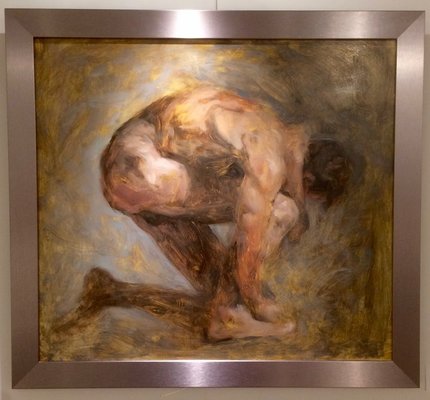In this blog post, I would like to explore the idea of "presence" as it is articulated in some of the works in the exhibition, which closed on April 23.
 "Ella" and "Curtains," Stephanie Denz; "Contemplation" and "Serenity," Lynn Demers
"Ella" and "Curtains," Stephanie Denz; "Contemplation" and "Serenity," Lynn Demers Below, Lynn Demers's bronze head sculptures "Contemplation" and "Serenity" convey another kind of presence, a confident sense of being that emanates from their polished surfaces and perfectly symmetrical features. These are idealized representations of the body conforming to traditional canons of beauty. The children are also idealized, that's true, but their sense of self remains connected to their bodies, while Demer's sculptures symbolize a "higher" state of being beyond the body, perhaps in the Platonic realm of eternal ideas or in the superconscious state beyond the senses and the intellect— the Atman or all-encompassing consciousness of Vedanta philosophy. Transcending the body to attain a state of pure presence. Presence through absence.
 "Teenage Girl," Renee Sanden
"Teenage Girl," Renee Sanden  "Emily," Alanda Nay
"Emily," Alanda Nay  "Portraits of Older Women," Susan Benson
"Portraits of Older Women," Susan Benson  "Crouching Man," Mel Williamson
"Crouching Man," Mel Williamson  "Self-Portrait of the Artist as Neil Young," John MacDonald
"Self-Portrait of the Artist as Neil Young," John MacDonald From the moment Narcissus saw his own image reflected on a pool, human beings have been compelled to create images of themselves, driven by the desire to recapture that first moment of self-recognition. But it is not only the self that we are compelled to represent. We are also drawn to the other, who is so similar to us and yet so different. The encounter with the other is always complicated by conflicting emotions: fear, excitement, hope, anxiety, doubt, joy ... We long to see ourselves reflected in their gaze, to be recognized or to be mirrored back "simplified," to paraphrase Joni Mitchell ; sometimes, to feel that things are more complex, that there is more to discover.
What we seek in the other, then, is a transformative experience, " a metamorphosis of the self." (Christopher Bollas, Collected Writings) Many times, we approach a work of art with the same trepidation, the same desire to be recognized and, thus, transformed by the aesthetic experience. Perhaps this is what we want from art, a change of perspective, a renewed awareness or simply the realization that some mysteries defy explanation.
Walking through the exhibition space and looking at the different representations of the body through the gaze of the other —different eyes, different media and materials— I felt as if I was encountering those bodies, as if they were presenting themselves to me, for the first time: children, teenagers, elderly people; the body in its social and spiritual dimensions; confined bodies; invisible bodies and exuberant bodies; bodies in motion and bodies at rest; the fleshy material body; the human and the inhuman. I also felt another kind presence, something I am not always aware of or sensitive to: the body of the work itself, the paint in all its unavoidable materiality, its allure and also its resistance to my controlling gaze. I became aware of the different materials used by the sculptors, their thematic significance and emotional weight. More importantly, I felt that these bodies— these works—were not fully finished but in the process of becoming, of being continuously transformed in my eyes, the eyes of the viewer. I knew then that I was the works' own "transformational object," the mirror on which they need to see themselves reflected. Art as an endless process of becoming, for the work and for the viewer. This is the true aesthetic experience.



 RSS Feed
RSS Feed
